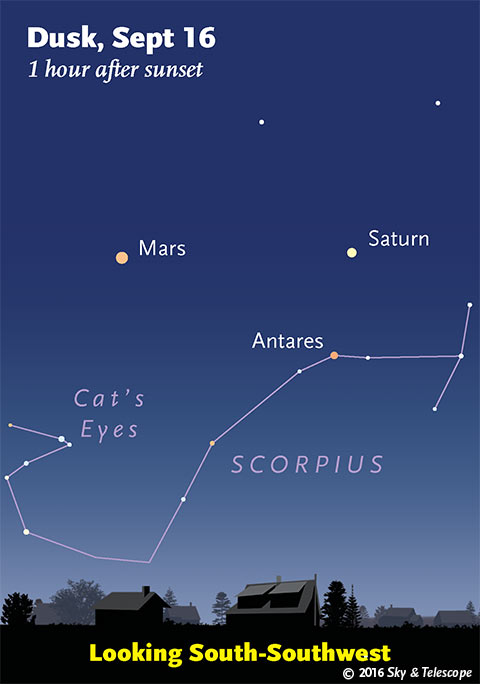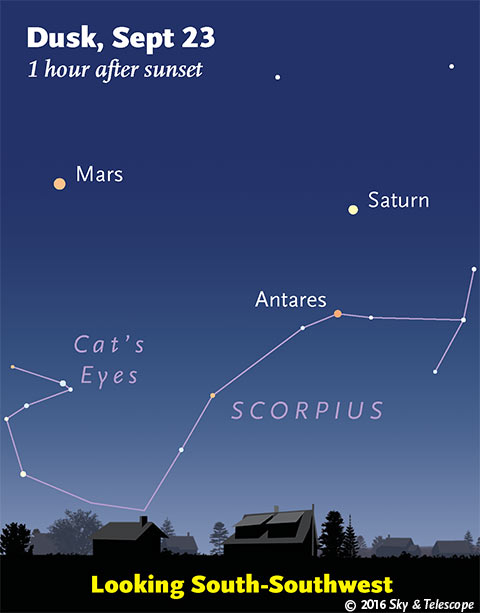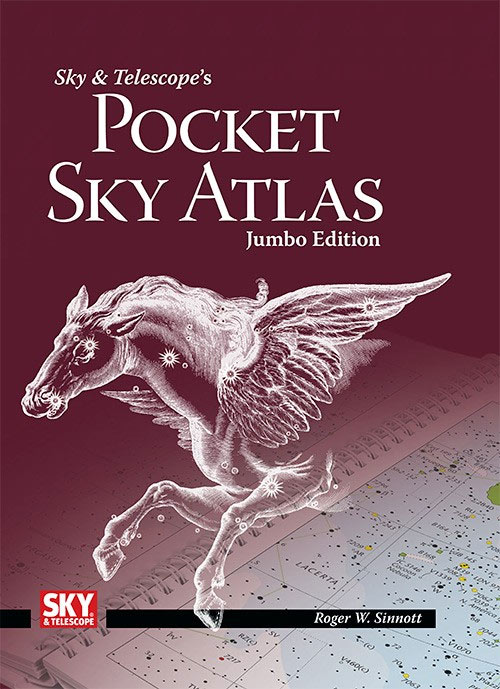

Friday, September 16
• Full Moon (exact at 3:05 p.m. Eastern Daylight Time). As night comes on, look for the Great Square of Pegasus to the Moon's upper left. The Square, a little larger than your fist held at arm's length, stands on one corner.
• A fairly deep penumbral (fringe) eclipse of the Moon is visible from eastern Europe, eastern Africa, Asia, and the westernmost Pacific. See our story: A Harvest Moon Penumbral Eclipse.
Saturday, September 17
• Now the Moon shines below the Great Square of Pegasus. From the Great Square's left corner extends a big line of three 2nd-magnitude stars, running to the lower left, that mark the head, backbone and leg of the constellation Andromeda. The line of three includes the Square's corner.
Upper left from the end of this line, you'll find W-shaped Cassiopeia tilting up.
Sunday, September 18
• About a half hour after sunset, you shouldn't have much trouble spotting Venus very low in the west-southwest through the twilight, if you have a clear view down that low. But can you see twinkly little Spica 2½° beneath Venus, perhaps as twilight fades further? You'll likely need binoculars or a telescope, the more so the farther north you live. Spica is only magnitude +1.0 compared to Venus's –3.9. In other words, it's only 1% as bright. (And that's before the more severe atmospheric extinction for lower Spica.)
Monday, September 19
• Arcturus shines in the west these evenings as twilight fades out. Equally-bright Capella is barely rising in the north-northeast, depending on your latitude (the farther north you are the higher it will be). Late in the evening, Arcturus and Capella shine at the same height in their respective compass directions. When will this happen? That depends on both your latitude and longitude. They're both magnitude 0.
Tuesday, September 20
• This is the time of year when, during the evening, the dim Little Dipper "dumps water" into the bowl of the Big Dipper way down below. The Big Dipper will dump it back in the evenings of spring.
Wednesday, September 21
• As summer ends, the Sagittarius Teapot moves west of due south during evening and tips increasingly far over, as if pouring out the last of summer. Look for it left of Mars.
Thursday, September 22
• Autumn begins in the Northern Hemisphere, and spring in the Southern Hemisphere, at the equinox: 10:21 a.m. Eastern Daylight Time (14:21 UT). This is when the Sun crosses the equator heading south for the season.
• Coincidentally, every year when summer turns to fall, Deneb takes over from brighter Vega as the zenith star around the time when twilight fades into night (for skywatchers at mid-northern latitudes).
Friday, September 23
• The W pattern of Cassiopeia stands high in the northeast after dark. The right-hand side of the W is tilted up.
Look along the second segment of the W counting down from the top. It's not quite horizontal. Notice the dim naked-eye stars along that segment (not counting its two ends). The one on the right is Eta Cassiopeiae, magnitude 3.4, a Sun-like star just 19 light-years away with an orange-dwarf companion — a lovely binary in a telescope.
The "one" on the left is a wide naked-eye pair, Upsilon1 and Upsilon2 Cassiopeiae, 0.3° apart. They're orange giants unrelated to each other, 200 and 400 light-years away.
• Last-quarter Moon (exact at 5:56 a.m. Eastern Daylight Time on this date). The Moon rises around midnight or 1 a.m. on the morning of Saturday the 24th. Once it's fairly well up you'll find that it's in Gemini, with Castor and Pollux to its left. Orion is much farther to its right.
Saturday, September 24
• This is the time of year when the rich Cygnus Milky Way crosses the zenith in the hour after nightfall is complete (for skywatchers at mid-northern latitudes). The Milky Way rises straight up from the southwest horizon, passed overhead, and runs straight down to the northeast.
_________________________
Want to become a better astronomer? Learn your way around the constellations! They're the key to locating everything fainter and deeper to hunt with binoculars or a telescope.
This is an outdoor nature hobby. For an easy-to-use constellation guide covering the whole evening sky, use the big monthly map in the center of each issue of Sky & Telescope, the essential guide to astronomy.

Once you get a telescope, to put it to good use you'll need a detailed, large-scale sky atlas (set of charts). The basic standard is the Pocket Sky Atlas (in either the original or new Jumbo Edition), which shows stars to magnitude 7.6.
Next up is the larger and deeper Sky Atlas 2000.0, plotting stars to magnitude 8.5, nearly three times as many. The next up, once you know your way around, is the even larger Uranometria 2000.0 (stars to magnitude 9.75). And read how to use sky charts with a telescope.
You'll also want a good deep-sky guidebook, such as Sue French's Deep-Sky Wonders collection (which includes its own charts), Sky Atlas 2000.0 Companion by Strong and Sinnott, or the bigger Night Sky Observer's Guide by Kepple and Sanner.
Can a computerized telescope replace charts? Not for beginners, I don't think, and not on mounts and tripods that are less than top-quality mechanically (meaning heavy and expensive). And as Terence Dickinson and Alan Dyer say in their Backyard Astronomer's Guide, "A full appreciation of the universe cannot come without developing the skills to find things in the sky and understanding how the sky works. This knowledge comes only by spending time under the stars with star maps in hand."
This Week's Planet Roundup
Mercury is buried deep in the glow of sunrise. But wait'll next week.
Venus (magnitude –3.8) is low in the west-southwest in twilight. Look for it there starting 20 or 30 minutes after sunset.
Mars (magnitude 0.0) continues moving eastward away from Saturn (magnitude +0.5) and Antares (+1.0, below and a bit left of Saturn). Look south-southwest at nightfall. The triangle they make keeps lengthening.
Mars crosses from Ophiuchus into Sagittarius this week. Look for the Sagittarius Teapot asterism to its left.
In a telescope, Mars is barely 10 arcseconds in diameter — only about two thirds the size of Saturn's globe, but much more brightly sunlit.
At Saturn, the Cassini mission has just begun its dramatic final year. See NASA press release.
Jupiter is lost in the sunset.
Uranus (magnitude 5.7, in Pisces) and Neptune (magnitude 7.8, in Aquarius) are well up by 11 p.m. in the east-southeast and south, respectively. Info and finder charts. Neptune was at opposition September 2nd. Uranus comes to opposition October 15th.
__________________________
All descriptions that relate to your horizon — including the words up, down, right, and left — are written for the world's mid-northern latitudes. Descriptions that also depend on longitude (mainly Moon positions) are for North America.
Eastern Daylight Time (EDT) is Universal Time (UT, UTC, or GMT) minus 4 hours.
__________________________
"This adventure is made possible by generations of searchers strictly adhering to a simple set of rules. Test ideas by experiments and observations. Build on those ideas that pass the test. Reject the ones that fail. Follow the evidence wherever it leads, and question everything. Accept these terms, and the cosmos is yours."
— Neil deGrasse Tyson
 1
1








Comments
Lynnsails
September 20, 2016 at 6:31 am
Just started and really enjoying the hobby. Before moonrise on Sunday...the ocean front was lit up with phosphorescent plankton while the orange moon (full just after harvest moon) slowly crept over the horizon. Cannot even imagine how to photograph except in our memory. Viewed Mars and Saturn for first time. What strength telescope does it take to see Saturn rings? We are using Celestron 15x70 binoculars.
You must be logged in to post a comment.
You must be logged in to post a comment.